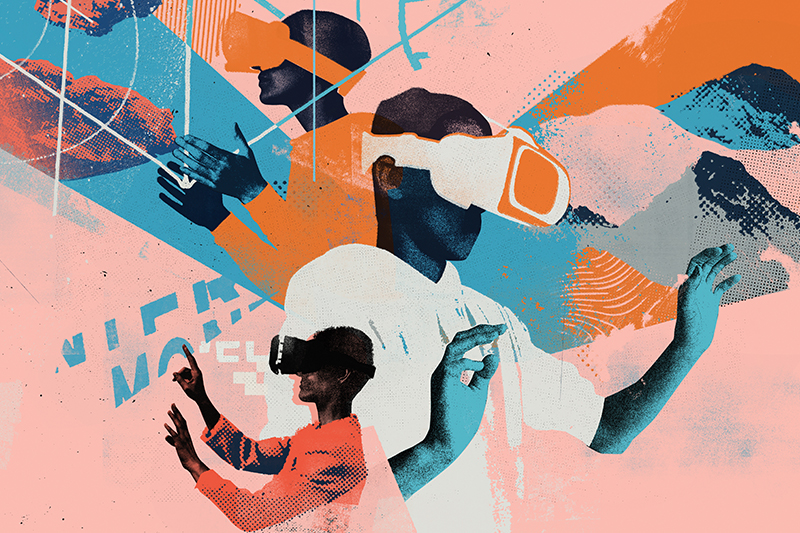Talent Development Leader
Immersive Technologies Sharpen Learners’ Skills
Tue Apr 25 2023

Bank of America is using virtual reality and artificial intelligence to transform learning.
Solution: Immersive technologies and interactive learning experiences to boost teammates’ confidence in client interactions
Business impact highlight: The virtual reality training solution expanded nearly all participants’ self-assurance with their skills.
For Bank of America, providing the best care to its clients is critical to business. To do that, the US financial institution ensures its clients, employees, and shareholders grow responsibly.
The Academy is the company’s onboarding, education, and professional development organization dedicated to employee growth and development. Through a focus on skill development and career progression, our team helps staff grow and build new competencies. Our educational tools and resources ensure that all employees, regardless of where they are in their careers, have access to continuous learning opportunities to develop and further hone the skills necessary to do their jobs and take personal ownership of their careers.
Bank of America has 200,000 employees—or teammates—across nearly 4,000 locations and branches, and the Academy team regularly requests feedback on our programs. When individuals relayed to us that they wanted more opportunities to practice in a safe environment before interacting with clients, we turned to immersive technologies.
A high-tech, high-touch approach
Training functions can leverage immersive technology in a variety of ways. We recognized that technology is an opportunity for teammates to gain valuable practice and develop crucial hard and soft skills in a controlled environment so they could build confidence for their day-to-day jobs.
To start, our team gathered concrete, actionable feedback from employees to narrow the scope into a few transformative technologies for the organization: systems simulators, conversation simulators using artificial intelligence, and fully immersive virtual reality simulators. Next, we determined the role each piece of technology could play and how to establish training opportunities for employees.
Conversation and platform simulators. In 2018, we launched an immersive learning program, the Academy Client Engagement Simulator, which helps employees practice common client transactions and develop new skills faster. It also offers teammates a place to practice interacting with clients and build muscle memory.
During the past few years, and in light of advances with AI, we have expanded simulator offerings. For example, by implementing AI into conversation simulators, we developed a coaching tool that replicates client interactions and is designed to sharpen individuals’ soft skills through interactive role-playing and real-time coaching. Through different training modules, learners can increase their speed and proficiency, bolstering their confidence to troubleshoot problems and lead successful client interactions.
VR training. After success with the simulators, we started using VR to expand training solutions. VR enables the company to simulate real-life scenarios that learners would likely encounter daily, giving them meaningful practice and confidence.
Individuals have access to several VR simulation modules to practice a wide range of skills, including strengthening and deepening relationships with clients, navigating difficult conversations, as well as listening and responding with empathy. While learning at their own pace, users also receive real-time correction and personalized feedback so they can refine the soft skills that are critical to success.
In 2019, we started with a 400-employee VR pilot training program to test how successful VR could be with teammates. The pilot revealed many benefits, such as enabling managers and employees to train and develop skills to have complex and nuanced conversations with their clients and each other.
Historically, we taught skills through instructor-led discussions and web-based training. By 2021, Bank of America integrated VR training into nearly 4,000 financial centers across the US, with plans to continue the expansion to other areas across the enterprise.
The metaverse. Last summer, the company welcomed new campus hires in New York City for a highly engaging onboarding initiative. The event featured several exciting new elements, including the Bank of America Metaverse Onboarding Experience, which leveraged VR capabilities to immerse new teammates in the company’s past, present, and future. The experience enabled new hires to experience Bank of America’s virtual campus and learn more about the company and culture via six exhibits.
An immersive future
While one-on-one coaching, computer-based training, and classroom training are valuable, the company’s investments in immersive technology and interactive learning solutions have revealed that tech tools have a lot of potential. One of the most significant lessons we have learned is that the tools have shown early promise for replicating real-life scenarios and giving teammates meaningful practice and confidence.
For instance, the VR pilot revealed that 97 percent of the participants felt more comfortable performing tasks after going through the simulations, and 90 percent said it was an enjoyable experience.
The biggest testament to the program’s success is teammates’ increased engagement with the training programs. They have also shared that they look forward to taking part in training opportunities. Some individuals have even shared with their family and friends outside of work how much they enjoyed the experience.
Successful companies listen to employee feedback on what they need to be successful and subsequently design programs that help meet those needs. Bank of America’s learning programs delivered via the Academy are an example of how technology-driven education such as AI and VR can drive positive results for employees and clients. We have only scratched the surface of technology’s potential to transform learning programs and will continue to listen and respond in innovative ways to employee learning needs.
Read more from Talent Development Leader.
